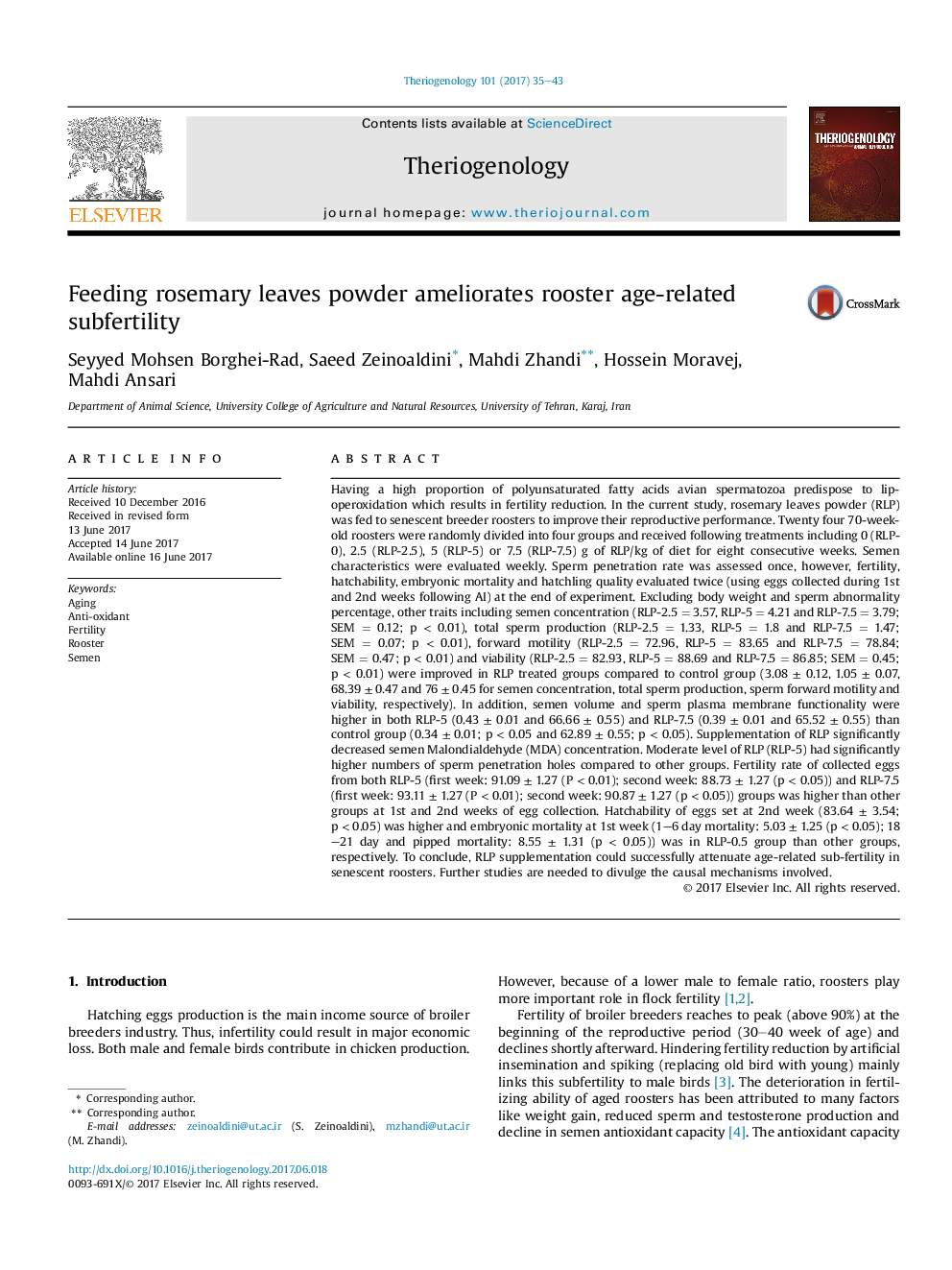| کد مقاله | کد نشریه | سال انتشار | مقاله انگلیسی | نسخه تمام متن |
|---|---|---|---|---|
| 5522961 | 1546068 | 2017 | 9 صفحه PDF | دانلود رایگان |
- Effect of dietary rosemary was studied on semen quality, fertility and hatchability.
- Feeding of 5Â g rosemary leaves powder/kg diet improved most of the seminal characteristics.
- Rosemary had no effect on abnormal spermatozoa, hatchability, embryonic mortality and hatchling quality.
- Fertility rate was ameliorated by feeding of 5 and 7.5Â g rosemary leaves powder/kg diet.
Having a high proportion of polyunsaturated fatty acids avian spermatozoa predispose to lipoperoxidation which results in fertility reduction. In the current study, rosemary leaves powder (RLP) was fed to senescent breeder roosters to improve their reproductive performance. Twenty four 70-week-old roosters were randomly divided into four groups and received following treatments including 0 (RLP-0), 2.5 (RLP-2.5), 5 (RLP-5) or 7.5 (RLP-7.5) g of RLP/kg of diet for eight consecutive weeks. Semen characteristics were evaluated weekly. Sperm penetration rate was assessed once, however, fertility, hatchability, embryonic mortality and hatchling quality evaluated twice (using eggs collected during 1st and 2nd weeks following AI) at the end of experiment. Excluding body weight and sperm abnormality percentage, other traits including semen concentration (RLP-2.5 = 3.57, RLP-5 = 4.21 and RLP-7.5 = 3.79; SEM = 0.12; p < 0.01), total sperm production (RLP-2.5 = 1.33, RLP-5 = 1.8 and RLP-7.5 = 1.47; SEM = 0.07; p < 0.01), forward motility (RLP-2.5 = 72.96, RLP-5 = 83.65 and RLP-7.5 = 78.84; SEM = 0.47; p < 0.01) and viability (RLP-2.5 = 82.93, RLP-5 = 88.69 and RLP-7.5 = 86.85; SEM = 0.45; p < 0.01) were improved in RLP treated groups compared to control group (3.08 ± 0.12, 1.05 ± 0.07, 68.39 ± 0.47 and 76 ± 0.45 for semen concentration, total sperm production, sperm forward motility and viability, respectively). In addition, semen volume and sperm plasma membrane functionality were higher in both RLP-5 (0.43 ± 0.01 and 66.66 ± 0.55) and RLP-7.5 (0.39 ± 0.01 and 65.52 ± 0.55) than control group (0.34 ± 0.01; p < 0.05 and 62.89 ± 0.55; p < 0.05). Supplementation of RLP significantly decreased semen Malondialdehyde (MDA) concentration. Moderate level of RLP (RLP-5) had significantly higher numbers of sperm penetration holes compared to other groups. Fertility rate of collected eggs from both RLP-5 (first week: 91.09 ± 1.27 (P < 0.01); second week: 88.73 ± 1.27 (p < 0.05)) and RLP-7.5 (first week: 93.11 ± 1.27 (P < 0.01); second week: 90.87 ± 1.27 (p < 0.05)) groups was higher than other groups at 1st and 2nd weeks of egg collection. Hatchability of eggs set at 2nd week (83.64 ± 3.54; p < 0.05) was higher and embryonic mortality at 1st week (1-6 day mortality: 5.03 ± 1.25 (p < 0.05); 18-21 day and pipped mortality: 8.55 ± 1.31 (p < 0.05)) was in RLP-0.5 group than other groups, respectively. To conclude, RLP supplementation could successfully attenuate age-related sub-fertility in senescent roosters. Further studies are needed to divulge the causal mechanisms involved.
Journal: Theriogenology - Volume 101, 1 October 2017, Pages 35-43
